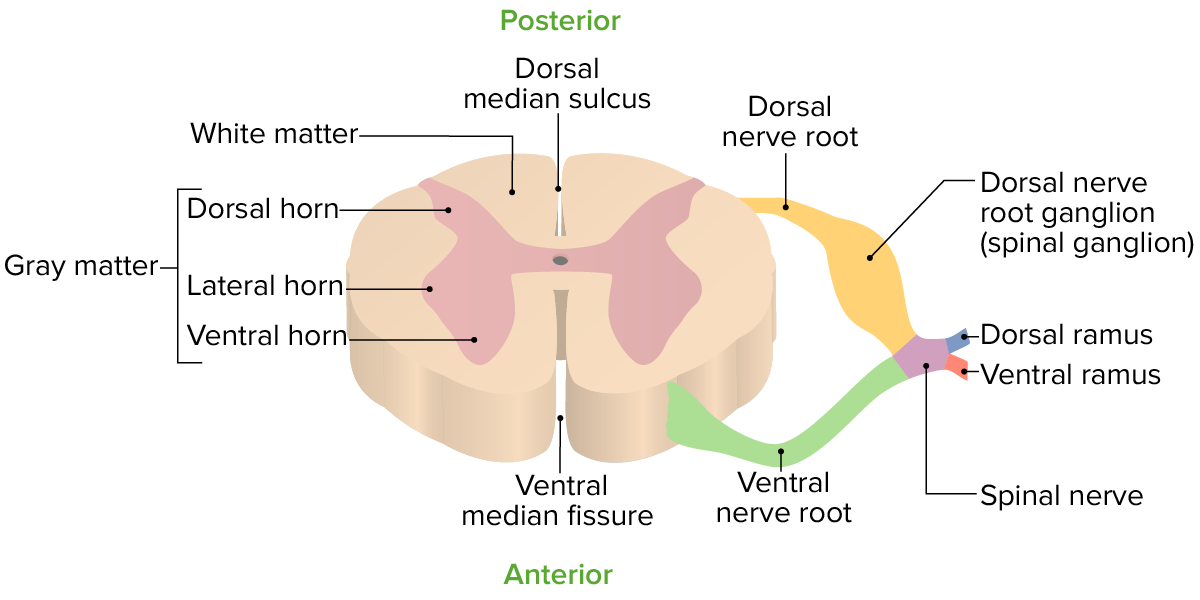Playlist
Show Playlist
Hide Playlist
Case: 53-year-old Woman with Progressive Weakness and Balance Difficulty
-
Slides Diseases of the Spinal Cord.pdf
-
Download Lecture Overview
00:00 So let's look at a case and look a little bit more at how we approach myelopathy. 00:07 This is a 53-year-old who presented with 1 year of progressive weakness and balance difficulty. This started 1 year ago with burning pain at the bottom of the feet and cramping in the legs. The cramping progressed to involve the hands and ultimately this patient started having problems with ambulation. So we're hearing about problems that start in the legs and may be working their way up to the arms and hands. About 6 months ago, her walking worsened. She began to require a cane for balance. She also started to notice more weakness in her hands and clumsiness with picking up items. So we have a disease that's progressively worsening over time and again involving the feet first and the arms second. About 3 months ago, she started using a rolling walker. She was referred to neurologic examination and evaluation. There's no bowel and bladder dysfunction and she does report a 25-pound weight loss in the past 1 year. There are a few key things to hone in on about this presentation. The first is the progressive nature of these symptoms slowly over time, which makes us worry about degenerative or structural or potentially neoplastic etiologies for this. 01:15 The patient had problems ambulating first, lower extremity symptoms first, followed by weakness in her hands. Upper extremity symptoms second. And that really suggest that this pathology may be coming from the outside of the spinal cord and then compressing inward. There's no bowel and bladder dysfunction and importantly those bowel and bladder nerves, the function of the bowel and bladder is contained within the central portion of the spinal cord and this again supports that this pathology must be coming from the outside of the spinal cord compressing in as opposed to something inside the cord and expanding out. So in this patient, if you're suspecting a spinal cord disorder, what other exam findings would help you to support this localization? Weakness in the legs? Cranial nerve dysfunction? Hyperreflexia in the legs bilaterally? Or urinary retention with overflow incontinence? Well, weakness of the legs we can see in spinal cord disorders. We call that a paraparesis, but we can also see that in other disorders. And classically Guillain-Barre or a peripheral nervous system disorder can present with bilateral leg weakness. So this is not specific to a spinal cord pathology or myelopathy. Cranial nerve dysfunction points to something in the brainstem or perhaps in the peripheral nerve and not in the spinal cord and so importantly evidence of cranial nerve dysfunction would put us in a completely different localization and bucket and would not support spinal cord pathology. Urinary retention with overflow incontinence would not be correct in this case. Incontinence can result from spinal cord pathology, but typically we see a spastic bladder from upper motor neuron dysfunction not overflow incontinence with urinary retention which is really more of a peripheral nervous system neurogenic bladder and would suggest cauda equina or other peripheral nerve disorder. The presence of hyperreflexia in the legs would be strongly suggestive of a spinal cord disorder in this patient and really would help the essential diagnosis of a clinical diagnosis of myelopathy.
About the Lecture
The lecture Case: 53-year-old Woman with Progressive Weakness and Balance Difficulty by Roy Strowd, MD is from the course Diseases of the Spinal Cord.
Included Quiz Questions
Which of the following best describes the pattern of symptom progression in a patient with myelopathy due to a lesion pressing on the spinal cord?
- Progressive worsening of symptoms that start in the lower extremities and ascend toward the upper extremities
- Progressive worsening of symptoms that start in the upper extremities and descend toward the lower extremities
- Sudden onset of symptoms that start in both the upper and the lower extremities
- Progressive worsening of symptoms only in the lower extremities
- Sudden onset of symptoms at the level of the lesion
Customer reviews
5,0 of 5 stars
| 5 Stars |
|
5 |
| 4 Stars |
|
0 |
| 3 Stars |
|
0 |
| 2 Stars |
|
0 |
| 1 Star |
|
0 |




